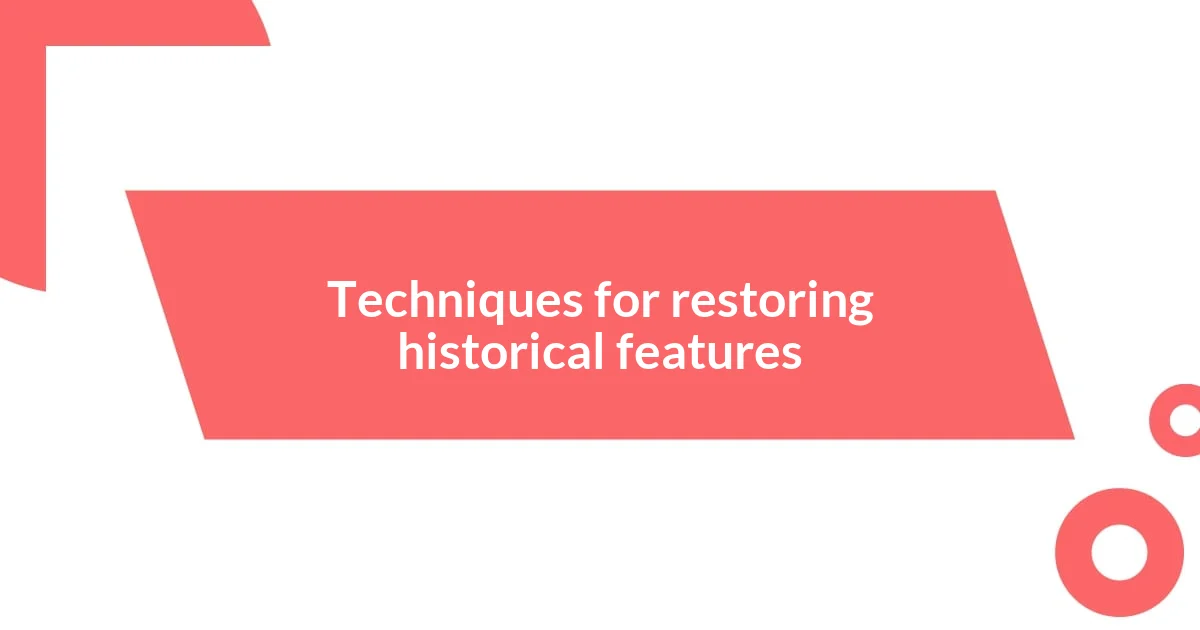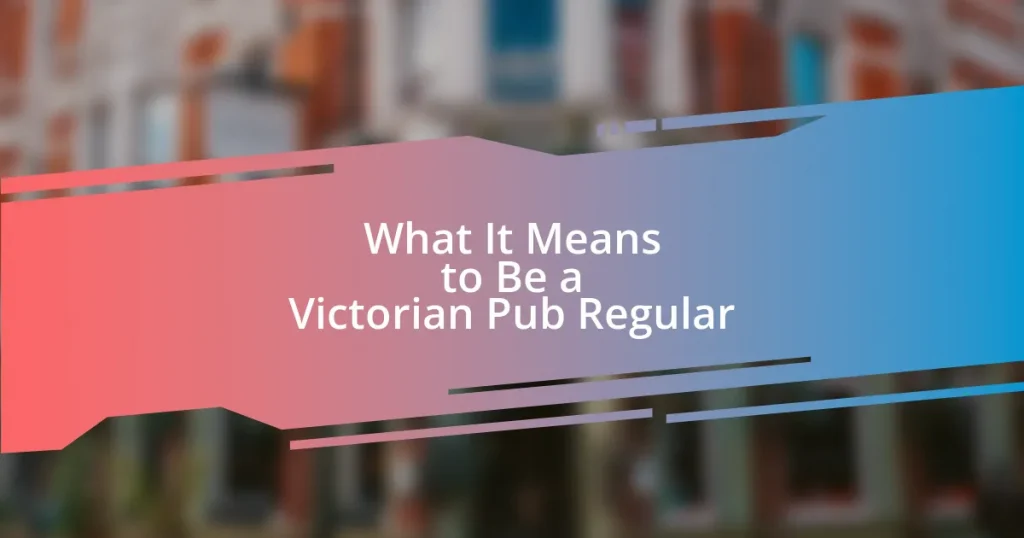Key takeaways:
- Understanding Georgian architecture requires appreciation of its elegance, symmetry, and relationship with natural light, enhancing the sense of history in restored spaces.
- Planning the restoration process is vital, focusing on research, budgeting, obtaining permits, and consulting professionals to ensure historical authenticity and sustainability.
- Embracing challenges, such as unexpected structural issues and matching original finishes, fosters resilience and deepens the emotional connection to the home’s history during restoration.

Understanding Georgian architecture
Georgian architecture is known for its timeless elegance and symmetry, featuring clean lines and balanced proportions. I remember walking through a restored Georgian neighborhood and being struck by the uniformity of the row houses; each one told a story through its windows and doorways. Isn’t it fascinating how such simple design principles can evoke such a sense of unity and history?
One of the fascinating aspects of Georgian homes is the use of classic detailing, like decorative cornices and pediments. I felt a wave of nostalgia as I carefully stripped layers of paint off an old cornice in my own project, revealing the intricate moldings that had been hidden for decades. Have you ever uncovered a hidden detail in a restoration project? It’s like finding a forgotten treasure that connects you to the past.
Additionally, Georgian architecture often emphasizes the importance of natural light, with large windows designed to draw in sunlight. I recall the thrill of standing in a freshly restored room, where the sunlight streamed through those tall windows, illuminating every corner. Can you imagine the joy of living in a space that feels both warm and inviting, reminding you daily of a history rich with character?

Planning the restoration process
Planning the restoration of a Georgian home can feel like preparing for a grand adventure. I quickly learned that a well-thought-out plan sets the tone for the entire process and can save you from unexpected hurdles down the line. In my case, creating a detailed timeline helped me visualize each stage of restoration, from the initial research to the final brushstroke.
Here are a few essential aspects to consider when crafting your restoration plan:
- Research Historical Authenticity: Understand the specific architectural features that define Georgian homes in your area.
- Budget Wisely: Allocate funds not just for materials but also for expertise, as some aspects may require skilled craftsmen.
- Get Required Permits: Check local regulations to ensure your renovations comply with historical preservation standards.
- Engage Professionals Early: Consult architects or preservationists who specialize in Georgian architecture early in the planning phase to guide your vision.
- Consider Sustainability: Choose eco-friendly materials to modernize the home while respecting its historical essence.
Reflecting on my own experience, planning gave me a sense of control, even amidst the chaos of restoration. I vividly remember that moment of clarity when I organized my tasks on a spreadsheet—it transformed my uncertainty into excitement. It’s like charting a course to a destination I had long dreamed of, and that journey made all the difference.

Essential tools for restoration
When it comes to restoring a Georgian home, having the right tools at your disposal is essential. During my journey, I discovered that a mix of both traditional tools and modern technology often yields the best results. For instance, a simple chisel can be indispensable when trying to fit old moldings, while a laser level ensures your work is precise and visually appealing.
It’s also crucial to think about your workspace. I remember investing in a quality workbench—it made all the difference when tackling larger projects like window restoration. Having a clean, organized space not only improves efficiency but sparks creativity, allowing for those “aha” moments that often lead to innovative solutions.
Lastly, don’t underestimate the importance of safety gear. While tools might steal the show, I learned the hard way that a sturdy pair of gloves and safety goggles are just as essential as a good hammer. It’s easy to get swept up in the excitement of transforming a space, but protecting yourself is paramount. After all, no one wants to sit back and admire their handiwork while nursing an injury!
| Tool | Purpose |
|---|---|
| Chisel | For carving and fitting moldings |
| Laser Level | For ensuring precise measurements |
| Workbench | To create an organized workspace |
| Safety Gear | For protecting yourself during restoration |

Techniques for restoring historical features
Restoring historical features requires meticulous attention to detail, and I quickly found that taking a patient approach made a world of difference. For example, when working on the ornate plaster cornices typical of Georgian style, I discovered the value of carefully documenting each element before removal. It felt almost like archaeology—preserving the history while ensuring every curve and angle matched the original. Have you ever held a piece of history in your hands and felt the responsibility that comes with it?
Another technique that proved invaluable was sourcing original materials or recreating them as closely as possible. I remember scouring local salvage yards for reclaimed wood that matched the antique flooring I was working to restore. The thrill of finding that perfect piece felt like unlocking a secret door to the past. Plus, each original element not only boosts the home’s character but also honors its legacy, weaving the old with the new.
Lastly, I learned that patience pays off when restoring detailed features. For instance, carefully stripping old paint layers to reveal the vibrant colors beneath was a lesson in perseverance. I found myself getting engrossed in the process, often losing track of time. It made me ponder: how often do we rush through our projects, missing the beauty in the fine details? Paying attention to these nuances not only rejuvenates the structure but also deepens our connection to its history.

Choosing the right materials
Choosing the right materials for your Georgian home restoration is a decision that weighs heavily on your overall success. I remember standing in a hardware store, overwhelmed by the sheer variety of options. It struck me that while modern materials might seem tempting due to their convenience, finding authentic replacements is critical—after all, we want to preserve history, not replace it, right?
As I began sourcing materials, I realized that texture and aging play significant roles in achieving an authentic look. I had a memorable experience discovering a dusty corner where craftsmen had left behind beautiful, aged bricks. The way they felt in my hands ignited my passion for restoring the home. I wondered, how can one replicate that warmth in a shiny new product? In many cases, I found that salvaged materials not only provided a better aesthetic but also contained stories that new ones simply didn’t hold.
Additionally, I learned the importance of considering how materials respond to the environment. For instance, when selecting paint, opting for breathable options that allow moisture to escape made a remarkable difference in the longevity of the work. It’s fascinating to think about how these choices impact the home over time. Isn’t it incredible how something as simple as paint can dictate the health of your walls? My experience taught me that informed decisions today lay the groundwork for your home’s future, allowing it to stand tall for generations to come.

Learning from challenges faced
There were plenty of challenges that emerged during the restoration. One that really caught my attention was the discovery of unexpected structural issues. I still vividly remember peeling back layers of drywall only to uncover sagging beams and rotting wood. It was frustrating, but in that moment, I learned to embrace the unexpected. Each setback became a lesson in flexibility; sometimes, you have to pivot your plans to preserve the integrity of the home.
Another significant challenge was the overwhelming task of matching original finishes and colors. I recall spending hours researching historical palettes and meticulously mixing paint to get that perfect shade. It felt like I was chasing a ghost—a color that existed long before my time. But that process ignited a deeper connection to the home’s history. Have you ever felt such a pull to create authenticity that it made the challenge worthwhile?
Perhaps the most profound learning moment came from the emotional ups and downs of the journey. There were days I felt defeated, standing in a room of half-finished projects, questioning if I could ever bring it all together. Yet, each time I overcame a hurdle, the satisfaction was immeasurable. It reminded me of the importance of resilience and the personal growth that comes from tackling challenges head-on. How often do we allow our fears to dictate our progress, missing out on growth and fulfillment? In the end, facing these trials transformed not only the house but also my perspective on restoration.















